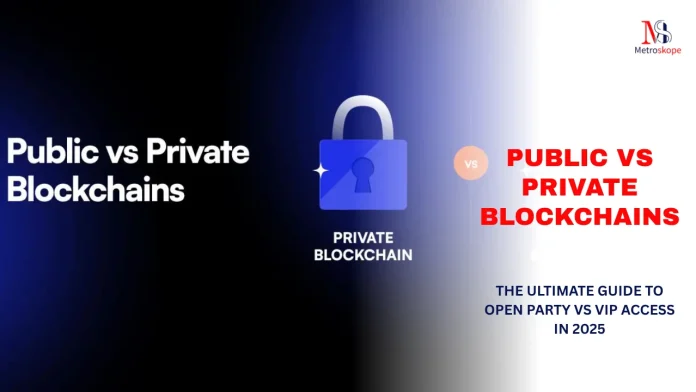Picture this: You’re planning two completely different parties. The first is an epic street festival where anyone can join, dance, eat, and contribute to the vibe – no guest list, no bouncers, just pure democratic chaos.
The second is an exclusive corporate gala with velvet ropes, security checks, and a carefully curated guest list where every attendee has been personally vetted.
Welcome to the fascinating world of public vs private blockchains – where the difference between an open party and VIP access literally shapes the future of digital transactions, data security, and technological innovation.
The Tale of Two Digital Worlds
In the blockchain universe, we essentially have two types of digital neighborhoods: the bustling public square where everyone’s welcome, and the private members-only club where entry requires special credentials.
Public blockchains are like that friend who invites the entire internet to their birthday party, while private blockchains are more like that exclusive book club that requires three references just to get in.
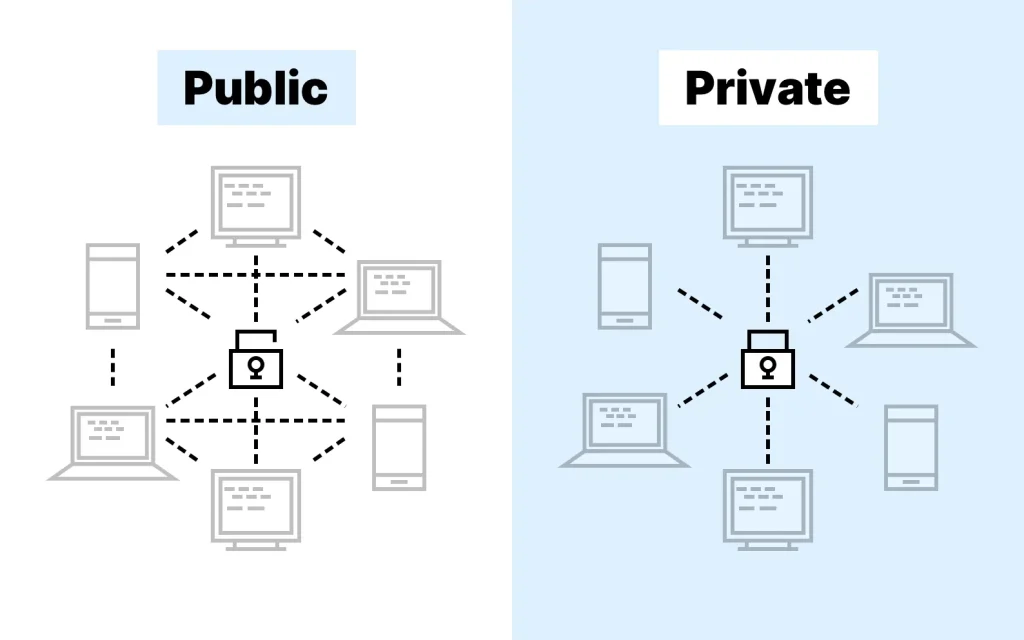
But here’s where it gets interesting – neither approach is inherently better than the other. It’s like asking whether a public library is better than a private study room.
The answer depends entirely on what you’re trying to accomplish, how much privacy you need, and whether you’re comfortable with strangers potentially reading over your shoulder.
Public Blockchains: The Digital Democracy
What Makes Them Tick?
Public blockchains are the ultimate democratic experiment in digital form. Anyone with an internet connection can join Bitcoin, Ethereum, or any other public network and start participating.
It’s like having a global town hall meeting that never ends, where every citizen gets to vote on every decision, and every transaction is recorded in a public ledger that everyone can read.
Key characteristics that make public blockchains special:
- Zero permission required – Just download the software and you’re in
- Complete transparency – Every transaction is visible to everyone
- True decentralization – No single entity controls the network
- Democratic consensus – The majority rules through various voting mechanisms
The Good, The Bad, and The Energy-Hungry
| Advantages | Disadvantages |
|---|---|
| Ultimate transparency – Every transaction is visible | Scalability nightmare – Bitcoin processes ~7 transactions per second |
| Censorship resistance – No central authority can shut it down | Energy consumption – Bitcoin mining uses more electricity than some countries |
| Global accessibility – Anyone, anywhere can participate | Privacy concerns – Your transaction history is public forever |
| True decentralization – Resilient to attacks and failures | Slow and expensive – Transaction fees can spike during busy periods |
“Public blockchains are decentralized, which means that no central authority controls the network. This makes the network more resilient to attacks and censorship.”
The beauty of public blockchains lies in their radical inclusivity. Whether you’re a tech mogul in Silicon Valley or a farmer in rural Kenya, you have exactly the same access rights.
It’s the closest thing we have to a truly global, democratized financial system.
Private Blockchains: The VIP Experience
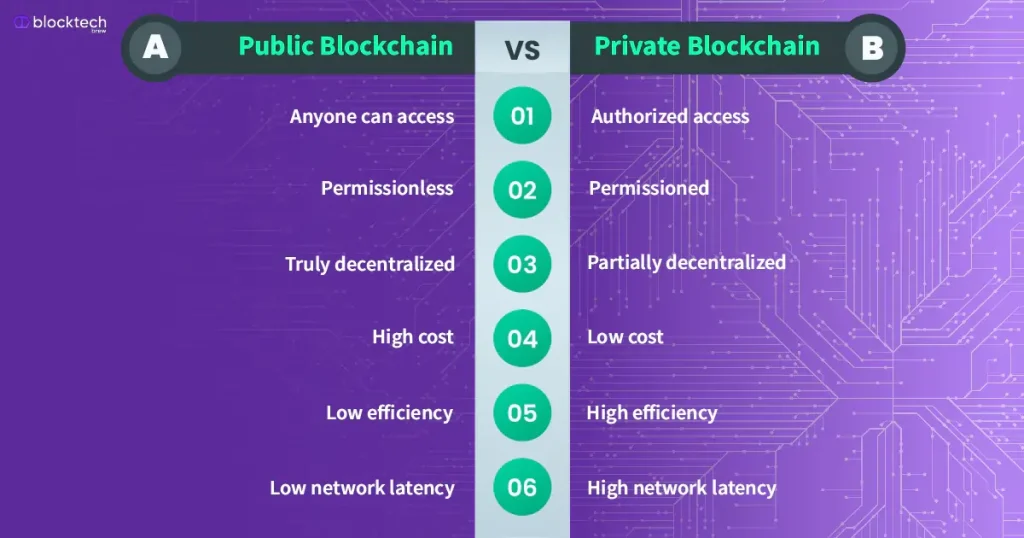
When Exclusivity Actually Makes Sense
Now, let’s crash the private party. Private blockchains are like having your own personal internet – all the benefits of blockchain technology, but with a carefully controlled guest list.
Only authorized participants can join, and there’s usually a central authority (think of them as the party host) who decides who gets in and what they can do once they’re there.
This isn’t about being elitist – it’s about practical business needs. Imagine if your company’s internal financial records were as public as Bitcoin transactions.
Your competitors would have a field day, and your accountants would probably quit on the spot.
The Enterprise Sweet Spot
Private blockchains shine in scenarios where you need:
- Data privacy – Some information just isn’t meant for public consumption
- Regulatory compliance – Many industries have strict rules about data handling
- Speed and efficiency – With fewer participants, transactions process much faster
- Cost predictability – No surprise fee spikes during network congestion
“Private blockchains have fewer participants and are more efficient than public blockchains. Their controlled nature and limited nodes facilitates higher throughput and faster transactions.”
The Great Comparison: Side by Side
| Feature | Public Blockchain | Private Blockchain |
|---|---|---|
| Access Control | Open to everyone | Invitation only |
| Transparency | Complete public visibility | Limited to authorized participants |
| Speed | Slower (Bitcoin: ~7 TPS) | Much faster (1000+ TPS possible) |
| Energy Use | High (especially Bitcoin) | Significantly lower |
| Cost | Variable, can be expensive | Lower and predictable |
| Governance | Decentralized/Democratic | Centralized/Controlled |
| Examples | Bitcoin, Ethereum, BNB | Hyperledger Fabric, R3 Corda |
| Best For | Cryptocurrencies, DeFi, global payments | Supply chain, healthcare, enterprise |
Real-World Applications: Where Each Shines
Public Blockchain Success Stories
Bitcoin: The OG public blockchain that started it all. Perfect for peer-to-peer digital cash without banks or governments getting in the way.
Ethereum: Takes public blockchain beyond just money, enabling smart contracts and decentralized applications that anyone can use or build upon.
Supply Chain Transparency: Companies like Walmart use public blockchains to let consumers trace their food from farm to table, creating trust through radical transparency.
Private Blockchain Champions
Healthcare Records: Hospitals use private blockchains to securely share patient data between authorized providers while maintaining strict privacy complianc.
Corporate Supply Chains: Companies like IBM use private blockchains to track products internally, getting blockchain’s benefits without exposing sensitive business data.
Financial Services: Banks use private blockchains for inter-bank transfers and settlements, enjoying faster processing while maintaining regulatory compliance.
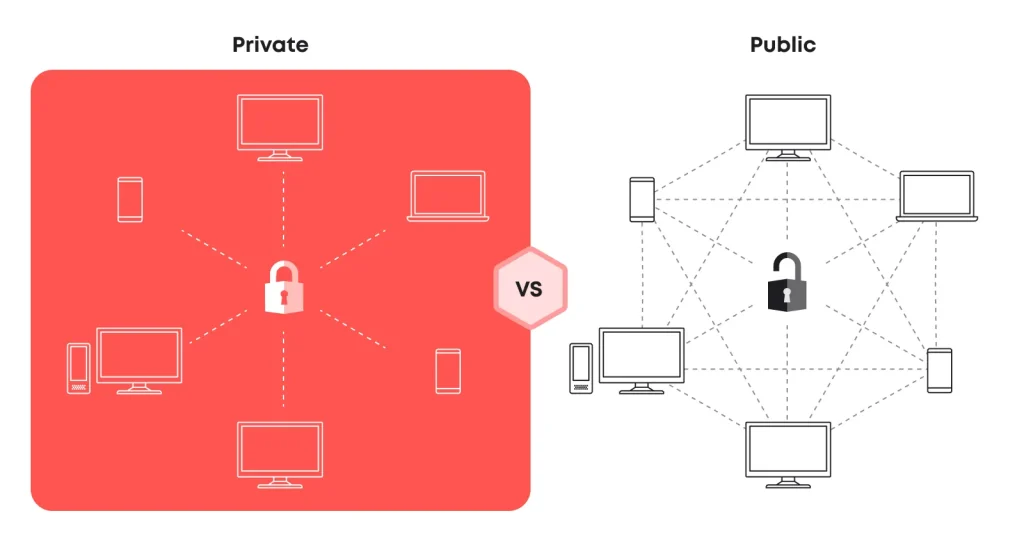
The Security Paradox: More Users = More Security?
Here’s where things get counterintuitive. Public blockchains are actually MORE secure than private ones in many ways, despite being completely open.
It’s like the difference between hiding your valuables in a house with one lock versus storing them in a bank vault watched by thousands of security guards.
In a public blockchain, thousands or millions of participants are constantly monitoring the network. To successfully attack Bitcoin, you’d need to control more than 51% of the network’s computing power – a feat that would cost billions of dollars and would be immediately noticed by the community.
Private blockchains, on the other hand, have fewer watchful eyes. With only a handful of trusted participants, there’s a higher risk that a single bad actor could cause significant damage.
“A public network is more secure due to decentralization and active participation. Due to the higher number of nodes in the network, it is nearly impossible for ‘bad actors’ to attack the system and gain control over the consensus network.”
The Hybrid Future: Best of Both Worlds?
Just when you thought the choice was binary, along come hybrid blockchains – the diplomatic solution to our digital party dilemma.
These clever systems let you have your cake and eat it too, combining the transparency benefits of public chains with the privacy controls of private ones.
Hybrid blockchains allow organizations to:
- Keep sensitive data private while making certain information public
- Control who can participate in different parts of the network
- Scale more efficiently than pure public chains
- Maintain regulatory compliance while still benefiting from decentralization
Making the Choice: Which Blockchain Fits Your Needs?
Choose Public Blockchain When:
- Transparency is crucial – You want everyone to be able to verify your claims
- Global accessibility matters – You need anyone, anywhere to participate
- Censorship resistance is important – No single entity should control your network
- You’re building a cryptocurrency or DeFi application
Choose Private Blockchain When:
- Data privacy is non-negotiable – Sensitive information must stay confidential
- Speed and efficiency are priorities – You need fast, predictable transaction processing
- Regulatory compliance is required – You operate in a heavily regulated industry
- You’re working within a specific organization or consortium
From Skepticism to Understanding
When I first learned about blockchain technology, the concept of a “trustless” system seemed almost offensive. How can you build trust without… trust?
But that’s the beautiful paradox of public blockchains – they create trust through transparency and mathematics rather than reputation and relationships.
Private blockchains, meanwhile, feel more familiar and comfortable. They work like traditional systems we already understand, just with blockchain’s added benefits of immutability and transparency (within the network).
The reality is that both approaches serve essential purposes in our increasingly digital world.
Public blockchains are pioneering new forms of global cooperation and financial inclusion, while private blockchains are helping traditional industries modernize and improve their operations.
No Wrong Choices, Only Wrong Applications
The debate between public and private blockchains isn’t really about which technology is superior – it’s about matching the right tool to the right job.
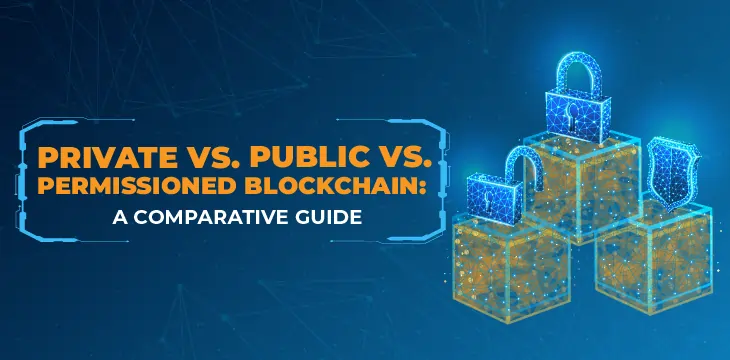
It’s like comparing a motorcycle to a truck. Both have engines and wheels, but you wouldn’t use a motorcycle to move furniture or take a truck on a scenic mountain ride.
Public blockchains excel at:
- Creating global, permissionless systems
- Enabling true decentralization
- Providing maximum transparency and trust
Private blockchains shine when:
- Privacy and control are paramount
- Speed and efficiency matter more than decentralization
- Regulatory compliance is non-negotiable
As we move into 2025 and beyond, the most successful blockchain implementations will likely be those that choose their architecture based on their specific use case rather than ideological preferences.
Whether you’re throwing an open street party or hosting an intimate dinner gathering, the key is knowing your audience and designing the experience accordingly.
The blockchain revolution isn’t just about the technology – it’s about reimagining how we can work together in a digital world. Public blockchains show us the power of radical transparency and global cooperation,
while private blockchains demonstrate how we can modernize existing systems while maintaining necessary controls.
In the end, the choice between public and private isn’t about picking sides in some technological war. It’s about building the digital future we actually want to live in – one where both open parties and VIP experiences have their place.

